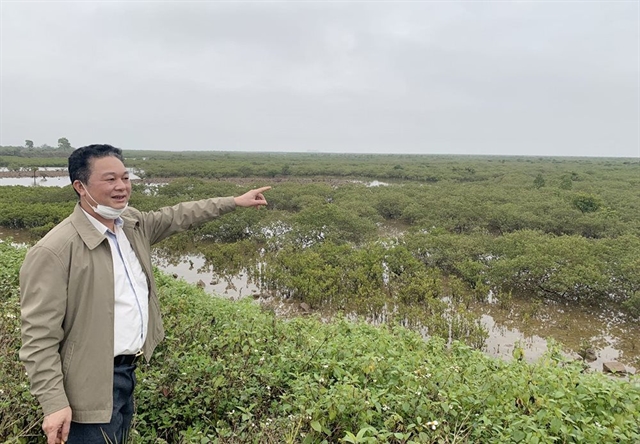
QUẢNG NINH — The coastal residents of Đầm Hà District, northern Quảng Ninh Province, are protecting mangrove forests to cope with climate change.
Along the dike route running through many coastal communes of Đầm Hà District, there are green mangrove forests that form a “green wall” that has been protecting villages and people in coastal communes of Tân Bình, Tân Lập, Đại Bình for generations.
Đầm Hà District has a coastline of more than 21km, an estuary and tidal flats of over 5,500ha, including more than 2,400ha of protected forest.
Director of the Protection Forest Management Board of Đầm Hà District, Phạm Văn Thuật, said seven years ago, Đầm Hà faced the risk of many mangrove forests being wiped out with more than 160ha of forest severely damaged by insecticides.
To save the forests, the Đầm Hà District authorities mobilised local people and equipment to kill insects using manual methods such as pruning the damaged leaves and using gasoline and oil to destroy worms.
After more than a week, the heavily damaged forest areas were zoned, and local authorities temporarily controlled insect-infested areas to prevent the damage from spreading to other forests.
Immediately after controlling the disease epidemic-hit area, the district authorities assessed the damage, re-checked the mangrove area, and mobilised the commune authorities and local people to newly-plant the damaged forest.
“Because the insect-affected mangrove forest is adjacent to the aquaculture area, it is not allowed to use chemicals and pesticides. We only use manual methods to control the spread of pests,” Thuật said. “Therefore, it is difficult to control the disease. However, with the determination of local authorities, agencies and people, the disease was controlled, and the mangrove forests recovered their green colour.”
Mè Văn Chuyên, a 60-year-old local, said the forests were familiar to people for generations, helping to protect people from violent waves and creating a new environment.
“Mangrove forests provide a shelter for aquatic species such as shrimp, crabs, fish and snails, which help local people to earn more income,” Chuyên said.
Trần Anh Cường, Vice Chairman of Đầm Hà District People’s Committee, said that the locality was accelerating a sustainable forest management plan until 2025.
The district authorities have also directed the coastal communes to regularly inspect aquaculture work to ensure that the mangrove forest area was not infringed.
The mangrove forest system in Đầm Hà is diverse, with many different types of trees.
Mangroves play an important role in protecting the sea dyke system, preventing wind and storms, regulating climate, limiting erosion and protecting villages.
They are also the homes of many aquatic species, generating income for local people and sustaining fishing and aquaculture.
Đầm Hà District has had authorities direct coastal communities to raise awareness about the effects of mangroves, mobilising people to participate in new planting and protection.
The district grows nearly 10 hectares of mangrove forests in coastal areas every year. Currently, 200ha of mangroves are located in the communes of Tân Bình, Đại Bình, and Tân Lập. — VnExpress News
- Reduce Hair Loss with PURA D’OR Gold Label Shampoo
- Castor Oil Has Made a “Huge” Difference With Hair and Brow Growth
- Excessive hair loss in men: Signs of illness that cannot be subjective
- Dịch Vụ SEO Website ở Los Angeles, CA: đưa trang web doanh nghiệp bạn lên top Google
- Nails Salon Sierra Madre
 VnExpress News The News Gateway of Vietnam
VnExpress News The News Gateway of Vietnam





